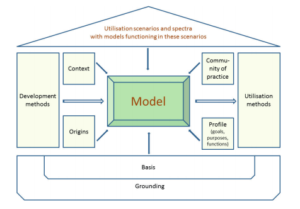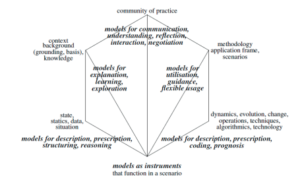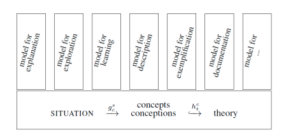今日推荐开源项目:《制作简历 Reactive-Resume》
今日推荐英文原文:《The Art of Modeling》

今日推荐开源项目:《制作简历 Reactive-Resume》传送门:GitHub链接
推荐理由:我们数年的经历,最终呈现在别人眼前的,不过一张简历而已。简历上面的每句话,都是脚印。
今日推荐英文原文:《The Art of Modeling》作者:The AI LAB
原文链接:https://medium.com/swlh/the-art-of-modeling-dece4322fe77
推荐理由:建模一直是科学与工程研究的核心内容之一。数学是一门艺术,用算法和逻辑构造的模型当然也是。
The Art of Modeling
Modeling is a topic that has implicitly been in the center of research in science and engineering since its beginnings. It has been considered as a side issue for long time. During the last 40 years it has gained more attention and becomes nowadays a sub-discipline in many disciplines.The earliest source of systematic model consideration we know is Heraklit with his λoγoς (logos). Model development and model deployment is almost as old as the mankind, however.
Essentially, it is an old sub-discipline of most natural sciences with a history of more than 2.500 years. It is often restricted to Mathematics and mathematical models what is however to much limiting the focus and the scope. The modeling method is a specific science method that uses models as instruments with certain intention or goal, e.g. for solving a task.
A Model is an Adequate and Dependable Instrument
A model is a well-formed, adequate, and dependable instrument that represents origins. Its criteria of well-formedness, adequacy, and dependability must be commonly accepted by its community of practice within some context and correspond to the functions that a model fulfills in utilization scenarios.
Figure 1 represents a model of the model. The development and utilization methods form the enabling aspects of the modeling method. Driving directives are
- (1) origins to be represented by the model,
- (2) purposes or goals or functions of models ,
- (3) the community of its users and developers, i.e. the community of practice, and
- (4) the context into which the model is embedded.

(Fig 1. Model of a Model)Typical functions of models are;
- a) cognition,
- b) explanation and demonstration,
- c) indication,
- d) variation and optimization,
- e) projection and construction,
- f) control,
- g) substitution, and
- h) experimentation.
Models and their Foundational Framework
The different orientations are the basis to distinguish the six concerns for models: community of practice, back- ground/knowledge/context, application scenario and stories of model utilization with their specific frames, situation/ state/data, dynamics/evolution/change/operations, and models as representations and instruments.
Figure 2 shows the relation between the concerns and the functions a model might have.

(Fig 2. Concerns and functions of a model)Models are used as
- perception models reflecting someone’s understanding,
- mental models that combine various perception models and that make use of cognitive structures and operations in common use,
- domain-situation models representing a commonly accepted understanding of a state of affairs within some application domain,
- experimentation models that guide experimentation,
- formal models based on some kind of formalism,
- mathematical models that are expressed in some mathematical language and based on some mathematical methods,
- conceptual models which combine models with some concept and conception space,
- computational models that are based on some (semi-)algorithm ,
- informative models that used to inform potential users about origins,
- inspiration models that provide an intuitive understanding of something,
- physical models that use some physical instrument,
- visualization models that provide a visualization,
- representation models that represent things like other models,
- diagrammatic models that are based on some diagram language with some kind of semantics,
- exploration models for property discovery,
- prototype models that represent a class of similar items,
- mould models that are used for production of artifacts,
- heuristic models that are based on some Fuzzy, probability, plausibility etc. relationship, etc.

(Fig 3. Different use cases of models)Model-based reasoning enhances classical reasoning such as reasoning mathematical calculi or logical derivation. There are several kinds of reasoning that are more appropriate and widely used: Evidence-based modeling and reasoning is one of the main approaches for quantitative models.
Models only represent acceptable possibilities. Each model captures a distinct set of possibilities to which the current description refers. Possibilities are consistent with the premises and the knowledge gained so far what makes them intrinsically uncertain because they mirror only some properties they represent.
In investigative and quantitative modeling, models can be proxy-driven where the the structure of the model corresponds to the proxies it represents. They might also include abstractions such as negation models.
Evidence-based modeling and reasoning uses pragmatic reasoning schemata, e.g. A causes B; B prevents C; therefore, A prevents C. The calculus may use several implication forms, e.g. deterministic conclusions (A cause B to occur: given A then B occurs) and ordered sets of possibilities (A enables B to occur: given A then it is possible for B to occur).
Hypothetical and investigative modeling considers different assumptions in order to see what follows from them, i.e. reasons about alternative possible worlds (i.e. states of the world), regardless of their resemblance to the actual world. Potential assumptions with their possible world conclusions and assertions are supported by a number of hypotheses (allowing to derive them). It is often combined with abductive reasoning. Evidence against hypothesis is performed by testing its logical consequences, i.e. exploring different alternative solutions in parallel to determine which approach or series of steps best solves a particular problem.
Causal reasoning and modeling is a specific variant of inductive reasoning and justification-backed truth maintenance with assertions (beliefs, background) and justifications within some context (current beliefs, justifications, arguments). It establishes the presence of causal relationships among events based on methods of agreement, difference, concomitant variation, and residues. It uses assumptions and thus avoids inconsistent sets (‘no good’ environment). The environment consists of a set of assumptions, premises, assumed statements, and derived statements for the world view. Justifications (e.g. data-supported) represent cause. Hypotheses are not derived from evidence but are added to evidence. They direct the search for evidence. They are tested by modus tollens ((H → I ) ∧ ¬I ⇒ ¬H ).
Network reasoning uses models that are expressed as networks. Nodes carry justification (arguments) and status (in, out, believed, relevant, necessary, …). Edges, hyper-edges, or directed edges have an antecedent (support nodes) and conclusions. They may also be non-monotonic and enable back-tracking for dependencies (causality, chronological, space, etc. Labels also express the degree of consistency and believability. Queries can be expressed as subgraphs and are evaluated by query embedding into the network.
Model-based reasoning is an interactive and iterative process that helps to digest a theory and to develop the theory. Therefore, model-based reasoning integrates many reasoning approaches, e.g. deduction, induction, abduction,
Model refinement might also be based on inverse modeling approaches. Facets of the last one are inductive learning, data mining, data analysis, generic modeling, universal applications, systematic modeling, and pattern-based reasoning.
While modeling is a very in-depth field, it certainly requires some level of systems thinking. After all, isn’t 21st century the age of big data and advanced tech systems all of which can be considered as separate models.
下载开源日报APP:https://openingsource.org/2579/
加入我们:https://openingsource.org/about/join/
关注我们:https://openingsource.org/about/love/
